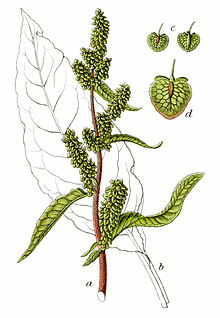Dock (plant)
| Rumex | |
|---|---|
 |
|
|
Patience dock (Rumex patientia) |
|
| Scientific classification | |
| Kingdom: | Plantae |
| (unranked): | Angiosperms |
| (unranked): | Eudicots |
| (unranked): | Core eudicots |
| Order: | Caryophyllales |
| Family: | Polygonaceae |
| Genus: |
Rumex L. 1753 |
| Type species | |
|
Rumex patientia L. |
|
| Species | |
| Synonyms | |
|
Lapathum Mill. |
|
| Nutritional value per 100 g (3.5 oz) | |
|---|---|
| Energy | 92 kJ (22 kcal) |
|
3.2 g
|
|
| Dietary fiber | 2.9 g |
|
0.7 g
|
|
|
2 g
|
|
| Vitamins | |
| Vitamin A equiv. |
(25%)
200 μg |
| Thiamine (B1) |
(3%)
0.04 mg |
| Riboflavin (B2) |
(8%)
0.1 mg |
| Niacin (B3) |
(3%)
0.5 mg |
| Vitamin B6 |
(9%)
0.122 mg |
| Folate (B9) |
(3%)
13 μg |
| Vitamin C |
(58%)
48 mg |
| Minerals | |
| Calcium |
(4%)
44 mg |
| Iron |
(18%)
2.4 mg |
| Magnesium |
(29%)
103 mg |
| Manganese |
(17%)
0.349 mg |
| Phosphorus |
(9%)
63 mg |
| Potassium |
(8%)
390 mg |
| Zinc |
(2%)
0.2 mg |
|
|
|
|
|
| Percentages are roughly approximated using US recommendations for adults. Source: USDA Nutrient Database |
|
Lapathum Mill.
Bucephalophora Pau
Sources: ING, UniProt, ITIS, IPNI, GRIN
The docks and sorrels, genus Rumex L., are a genus of about 200 species of annual, biennial, and perennial herbs in the buckwheat family Polygonaceae.
Members of this family are very common perennial herbs growing mainly in the Northern Hemisphere, but various species have been introduced almost everywhere.
Some are nuisance weeds (and are sometimes called dockweed or dock weed), but some are grown for their edible leaves.
Rumex species are used as food plants by the larvae of a number of Lepidoptera species.
They are erect plants, usually with long taproots. The fleshy to leathery leaves form a basal rosette at the root. The basal leaves may be different from those near the inflorescence. They may or may not have stipules. Minor leaf veins occur. The leaf blade margins are entire or crenate.
The usually inconspicuous flowers are carried above the leaves in clusters. The fertile flowers are mostly hermaphrodites, or they may be functionally male or female. The flowers and seeds grow on long clusters at the top of a stalk emerging from the basal rosette; in many species, the flowers are green, but in some (such as sheep's sorrel, Rumex acetosella) the flowers and their stems may be brick-red. Each seed is a three-sided achene, often with a round tubercle on one or all three sides.
...
Wikipedia
